refuelling Seat Leon 5D 2011 Owner's manual
[x] Cancel search | Manufacturer: SEAT, Model Year: 2011, Model line: Leon 5D, Model: Seat Leon 5D 2011Pages: 302, PDF Size: 4.17 MB
Page 6 of 302
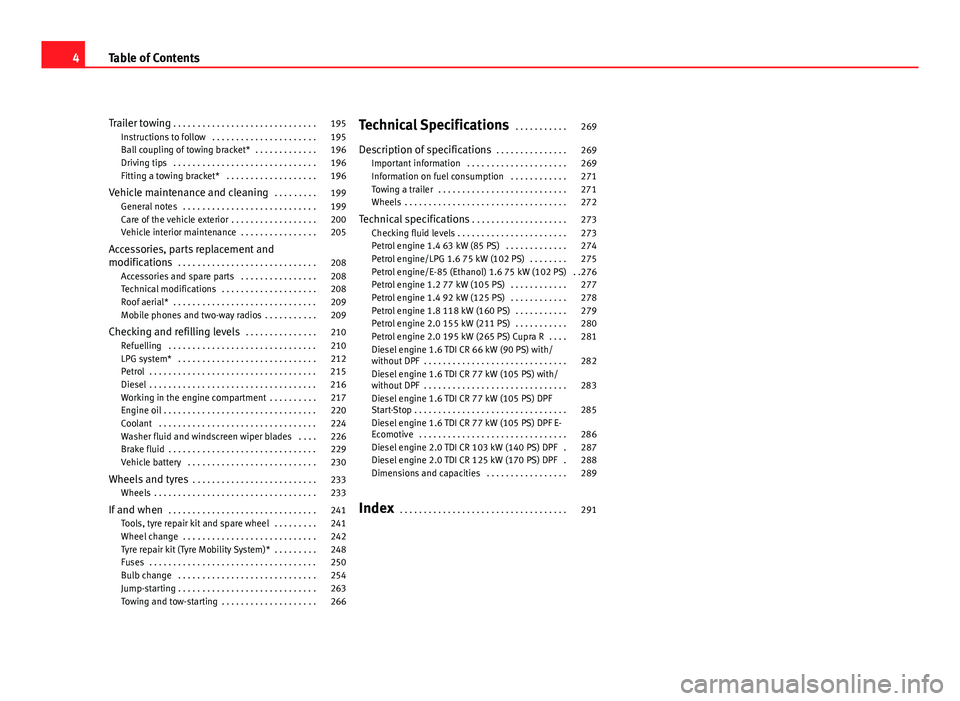
Trailer towing . . . . . . . . . . . . . . . . . . . . . . . . . . . . . . 195
Instructions to follow . . . . . . . . . . . . . . . . . . . . . . 195
Ball coupling of towing bracket* . . . . . . . . . . . . . 196
Driving tips . . . . . . . . . . . . . . . . . . . . . . . . . . . . . . 196
Fitting a towing bracket* . . . . . . . . . . . . . . . . . . . 196
Vehicle maintenance and cleaning . . . . . . . . . 199
General notes . . . . . . . . . . . . . . . . . . . . . . . . . . . . 199
Care of the vehicle exterior . . . . . . . . . . . . . . . . . . 200
Vehicle interior maintenance . . . . . . . . . . . . . . . . 205
Accessories, parts replacement and
modifications . . . . . . . . . . . . . . . . . . . . . . . . . . . . . 208
Accessories and spare parts . . . . . . . . . . . . . . . . 208
Technical modifications . . . . . . . . . . . . . . . . . . . . 208
Roof aerial* . . . . . . . . . . . . . . . . . . . . . . . . . . . . . . 209
Mobile phones and two-way radios . . . . . . . . . . . 209
Checking and refilling levels . . . . . . . . . . . . . . . 210
Refuelling . . . . . . . . . . . . . . . . . . . . . . . . . . . . . . . 210
LPG system* . . . . . . . . . . . . . . . . . . . . . . . . . . . . . 212
Petrol . . . . . . . . . . . . . . . . . . . . . . . . . . . . . . . . . . . 215
Diesel . . . . . . . . . . . . . . . . . . . . . . . . . . . . . . . . . . . 216
Working in the engine compartment . . . . . . . . . . 217
Engine oil . . . . . . . . . . . . . . . . . . . . . . . . . . . . . . . . 220
Coolant . . . . . . . . . . . . . . . . . . . . . . . . . . . . . . . . . 224
Washer fluid and windscreen wiper blades . . . . 226
Brake fluid . . . . . . . . . . . . . . . . . . . . . . . . . . . . . . . 229
Vehicle battery . . . . . . . . . . . . . . . . . . . . . . . . . . . 230
Wheels and tyres . . . . . . . . . . . . . . . . . . . . . . . . . . 233
Wheels . . . . . . . . . . . . . . . . . . . . . . . . . . . . . . . . . . 233
If and when . . . . . . . . . . . . . . . . . . . . . . . . . . . . . . . 241
Tools, tyre repair kit and spare wheel . . . . . . . . . 241
Wheel change . . . . . . . . . . . . . . . . . . . . . . . . . . . . 242
Tyre repair kit (Tyre Mobility System)* . . . . . . . . . 248
Fuses . . . . . . . . . . . . . . . . . . . . . . . . . . . . . . . . . . . 250
Bulb change . . . . . . . . . . . . . . . . . . . . . . . . . . . . . 254
Jump-starting . . . . . . . . . . . . . . . . . . . . . . . . . . . . . 263
Towing and tow-starting . . . . . . . . . . . . . . . . . . . . 266 Technical Specifications
. . . . . . . . . . . 269
Description of specifications . . . . . . . . . . . . . . . 269
Important information . . . . . . . . . . . . . . . . . . . . . 269
Information on fuel consumption . . . . . . . . . . . . 271
Towing a trailer . . . . . . . . . . . . . . . . . . . . . . . . . . . 271
Wheels . . . . . . . . . . . . . . . . . . . . . . . . . . . . . . . . . . 272
Technical specifications . . . . . . . . . . . . . . . . . . . . 273
Checking fluid levels . . . . . . . . . . . . . . . . . . . . . . . 273
Petrol engine 1.4 63 kW (85 PS) . . . . . . . . . . . . . 274
Petrol engine/LPG 1.6 75 kW (102 PS) . . . . . . . . 275
Petrol engine/E-85 (Ethanol) 1.6 75 kW (102 PS) . .276
Petrol engine 1.2 77 kW (105 PS) . . . . . . . . . . . . 277
Petrol engine 1.4 92 kW (125 PS) . . . . . . . . . . . . 278
Petrol engine 1.8 118 kW (160 PS) . . . . . . . . . . . 279
Petrol engine 2.0 155 kW (211 PS) . . . . . . . . . . . 280
Petrol engine 2.0 195 kW (265 PS) Cupra R . . . . 281
Diesel engine 1.6 TDI CR 66 kW (90 PS) with/
without DPF . . . . . . . . . . . . . . . . . . . . . . . . . . . . . . 282
Diesel engine 1.6 TDI CR 77 kW (105 PS) with/
without DPF . . . . . . . . . . . . . . . . . . . . . . . . . . . . . . 283
Diesel engine 1.6 TDI CR 77 kW (105 PS) DPF
Start-Stop . . . . . . . . . . . . . . . . . . . . . . . . . . . . . . . . 285
Diesel engine 1.6 TDI CR 77 kW (105 PS) DPF E-
Ecomotive . . . . . . . . . . . . . . . . . . . . . . . . . . . . . . . 286
Diesel engine 2.0 TDI CR 103 kW (140 PS) DPF . 287
Diesel engine 2.0 TDI CR 125 kW (170 PS) DPF . 288
Dimensions and capacities . . . . . . . . . . . . . . . . . 289
Index . . . . . . . . . . . . . . . . . . . . . . . . . . . . . . . . . . . 291
4Table of Contents
Page 62 of 302
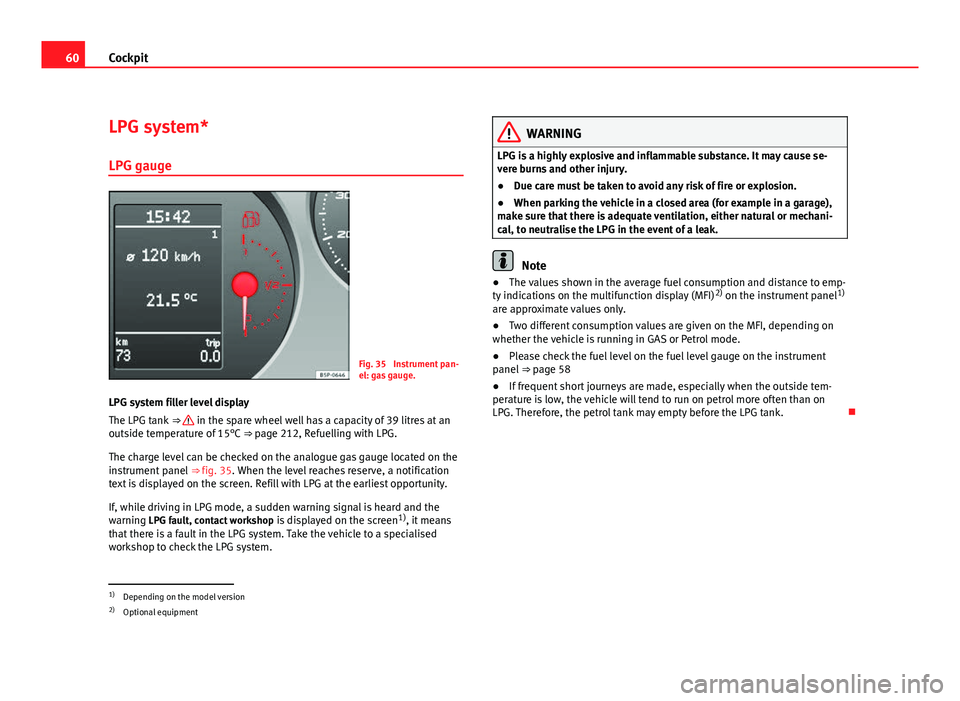
60Cockpit
LPG system*
LPG gauge
Fig. 35 Instrument pan-
el: gas gauge.
LPG system filler level display
The LPG tank ⇒
in the spare wheel well has a capacity of 39 litres at an
outside temperature of 15°C ⇒ page 212, Refuelling with LPG.
The charge level can be checked on the analogue gas gauge located on the
instrument panel ⇒ fig. 35. When the level reaches reserve, a notification
text is displayed on the screen. Refill with LPG at the earliest opportunity.
If, while driving in LPG mode, a sudden warning signal is heard and the
warning LPG fault, contact workshop is displayed on the screen1)
, it means
that there is a fault in the LPG system. Take the vehicle to a specialised
workshop to check the LPG system.
WARNING
LPG is a highly explosive and inflammable substance. It may cause se-
vere burns and other injury.
● Due care must be taken to avoid any risk of fire or explosion.
● When parking the vehicle in a closed area (for example in a garage),
make sure that there is adequate ventilation, either natural or mechani-
cal, to neutralise the LPG in the event of a leak.
Note
● The values shown in the average fuel consumption and distance to emp-
ty indications on the multifunction display (MFI) 2)
on the instrument panel 1)
are approximate values only.
● Two different consumption values are given on the MFI, depending on
whether the vehicle is running in GAS or Petrol mode.
● Please check the fuel level on the fuel level gauge on the instrument
panel ⇒ page 58
● If frequent short journeys are made, especially when the outside tem-
perature is low, the vehicle will tend to run on petrol more often than on
LPG. Therefore, the petrol tank may empty before the LPG tank.
1)
Depending on the model version
2) Optional equipment
Page 163 of 302
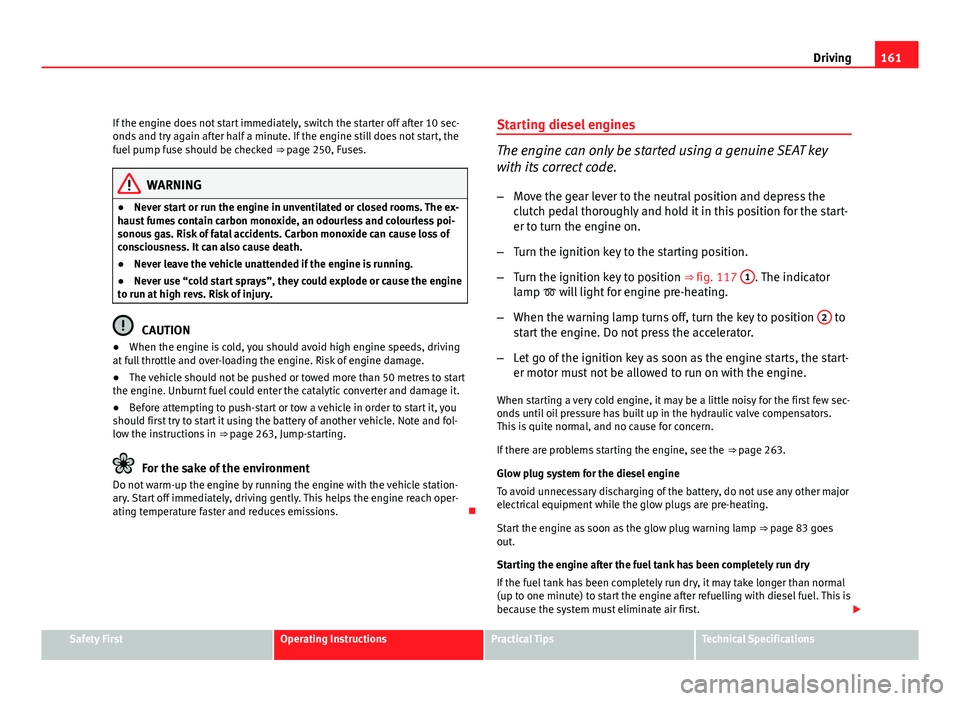
161
Driving
If the engine does not start immediately, switch the starter off after 10 sec-
onds and try again after half a minute. If the engine still does not start, the
fuel pump fuse should be checked ⇒ page 250, Fuses.
WARNING
● Never start or run the engine in unventilated or closed rooms. The ex-
haust fumes contain carbon monoxide, an odourless and colourless poi-
sonous gas. Risk of fatal accidents. Carbon monoxide can cause loss of
consciousness. It can also cause death.
● Never leave the vehicle unattended if the engine is running.
● Never use “cold start sprays”, they could explode or cause the engine
to run at high revs. Risk of injury.
CAUTION
● When the engine is cold, you should avoid high engine speeds, driving
at full throttle and over-loading the engine. Risk of engine damage.
● The vehicle should not be pushed or towed more than 50 metres to start
the engine. Unburnt fuel could enter the catalytic converter and damage it.
● Before attempting to push-start or tow a vehicle in order to start it, you
should first try to start it using the battery of another vehicle. Note and fol-
low the instructions in ⇒ page 263, Jump-starting.
For the sake of the environment
Do not warm-up the engine by running the engine with the vehicle station-
ary. Start off immediately, driving gently. This helps the engine reach oper-
ating temperature faster and reduces emissions. Starting diesel engines
The engine can only be started using a genuine SEAT key
with its correct code.
– Move the gear lever to the neutral position and depress the
clutch pedal thoroughly and hold it in this position for the start-
er to turn the engine on.
– Turn the ignition key to the starting position.
– Turn the ignition key to position ⇒ fig. 117 1
. The indicator
lamp will light for engine pre-heating.
– When the warning lamp turns off, turn the key to position 2
to
start the engine. Do not press the accelerator.
– Let go of the ignition key as soon as the engine starts, the start-
er motor must not be allowed to run on with the engine.
When starting a very cold engine, it may be a little noisy for the first few sec-
onds until oil pressure has built up in the hydraulic valve compensators.
This is quite normal, and no cause for concern.
If there are problems starting the engine, see the ⇒ page 263.
Glow plug system for the diesel engine
To avoid unnecessary discharging of the battery, do not use any other major
electrical equipment while the glow plugs are pre-heating.
Start the engine as soon as the glow plug warning lamp ⇒ page 83 goes
out.
Starting the engine after the fuel tank has been completely run dry
If the fuel tank has been completely run dry, it may take longer than normal
(up to one minute) to start the engine after refuelling with diesel fuel. This is
because the system must eliminate air first.
Safety FirstOperating InstructionsPractical TipsTechnical Specifications
Page 165 of 302

163
Driving
Driving with LPG*
Fig. 118 Centre console:
gas system control
switch.
Your SEAT vehicle has a bivalent engine able to run on either LPG or petrol.
The LPG tank ⇒ page 212, Refuelling with LPG is in the spare wheel well
⇒
.
It is possible to change from LPG to petrol while the engine is running, even
if the vehicle is moving, by pressing the GAS
button located on the centre
console ⇒ fig. 118. The selected operating mode is displayed on the indica-
tor lamp on the instrument panel ⇒ page 79.
Starting the engine
The engine is always started with petrol, even when LPG was being used
when it was switched off.
Automatic switch from petrol to LPG
When the engine is turned on and the following conditions are met, the sys-
tem will automatically switch from petrol mode to LPG mode, the notifica-
tion changed to GAS mode is displayed and the green indicator lamp on the
instrument panel lights up: ●
There is enough LPG in the tank.
● The temperature of the vehicle coolant is above 30°C.
● Engine speed while driving is above 1200 rpm.
Automatic switch from LPG to petrol
When the vehicle is operating in LPG mode and one of these conditions is
met, the system automatically switches to petrol mode, the notification changed to petrol mode is displayed and the green indicator lamp on the in-
strument panel goes out:
● When the engine is started.
● If the LPG tank is empty.
● If there is a fault in the LPG system.
● At very low temperatures, below -10°C.
Manual switch from petrol to LPG
Press the GAS
button on the centre console ⇒
fig. 118 to change mode. The
notification changed to GAS mode is displayed. When the following condi-
tions are met, the system switches to LPG mode, the green indicator lamp
on the instrument panel lights up and the notification displayed changes to changed to GAS mode .
● There is enough LPG in the tank.
● The temperature of the vehicle coolant is above 30°C.
● Engine speed while driving is above 1200 rpm.
Manual switch from LPG to petrol
Press the GAS
button on the centre console ⇒ fig. 118 to change mode. The
green lamp on the instrument panel goes out and the notification changed
to petrol mode is displayed.
Running on petrol
Run the engine with petrol for short journeys at regular intervals to avoid
problems in the petrol system.
Safety FirstOperating InstructionsPractical TipsTechnical Specifications
Page 196 of 302
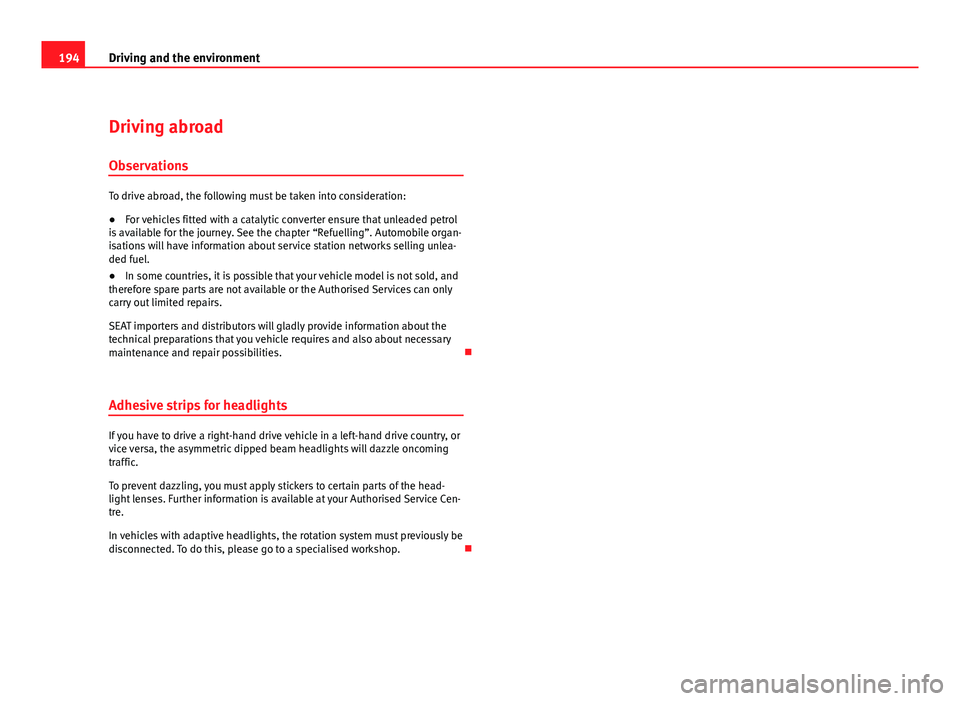
194Driving and the environment
Driving abroad
Observations
To drive abroad, the following must be taken into consideration:
● For vehicles fitted with a catalytic converter ensure that unleaded petrol
is available for the journey. See the chapter “Refuelling”. Automobile organ-
isations will have information about service station networks selling unlea-
ded fuel.
● In some countries, it is possible that your vehicle model is not sold, and
therefore spare parts are not available or the Authorised Services can only
carry out limited repairs.
SEAT importers and distributors will gladly provide information about the
technical preparations that you vehicle requires and also about necessary
maintenance and repair possibilities.
Adhesive strips for headlights
If you have to drive a right-hand drive vehicle in a left-hand drive country, or
vice versa, the asymmetric dipped beam headlights will dazzle oncoming
traffic.
To prevent dazzling, you must apply stickers to certain parts of the head-
light lenses. Further information is available at your Authorised Service Cen-
tre.
In vehicles with adaptive headlights, the rotation system must previously be
disconnected. To do this, please go to a specialised workshop.
Page 212 of 302

210Checking and refilling levels
Checking and refilling levels
Refuelling
The fuel cap cover opens automatically with the central lock-
ing system. The tank holds approximately 55 litres.
Fig. 138 Tank flap open
Unscrewing the tank cap
– Lift the lid.
– Unscrew the cap, turning it anti-clockwise.
Closing the tank cap
– Screw the tank cap to the right, until the point of feeling a
“click”.
– Close the drawer. Make sure you hear it click into place. The
tank cap is secured with an anti-loss attachment The tank flap is at the rear of the vehicle on the right.
If the automatic filler nozzle is operated correctly, it will switch itself off as
soon as the tank is “full”. Never attempt to fill beyond this point, as this will
fill the expansion chamber. Fuel may leak out if ambient conditions are
warm.
The correct fuel grade for your vehicle is given on a sticker on the inside of
the fuel tank flap. Here you will find further information on fuel.
Releasing the fuel tank flap manually
If the central locking system fails, the fuel tank flap can be opened manually
as follows:
●
Open the tailgate
● Remove the cover from the right side trim in the luggage compartment.
● Insert a hand and pull the locking device back
● Open the cap and take out the plug.
Page 214 of 302

212Checking and refilling levels
LPG system*
Refuelling with LPG
The LPG filler neck is behind the fuel cap, next to the petrol filler neck.
Fig. 139 Fuel tank open with LPG filler neck and adapt-
er.
Fig. 140 LPG tank in
spare wheel well Refuelling with LPG
–
Before refuelling, stop the engine and switch off the ignition.
– Open the tank flap.
– Before refuelling, please read the instructions on the pump.
– Unscrew the cap of the gas filler neck 1
.
– Screw the required adapter 2
on the gas filler neck 1.
– Refuel as indicated in the instructions on the pump.
– Unscrew the adapter 2
.
Page 215 of 302

213
Checking and refilling levels
– Screw on the cap of the gas filler neck 1
.
– Close the tank flap.
When the hose is removed from the tank, a small amount of LPG may spill
out ⇒
.
The LPG tank ⇒ fig. 140 in the spare wheel well has a capacity of 39 litres. If
the outside temperatures are very low, it may not be possible to completely
fill the LPG tank.
Pump attachments
There are a variety of types of LPG pump, and the methods of use may vary.
Therefore, let the pump operator fill the tank when refuelling for the first
time or fill from another pump.
Noises when refuelling with LPG
When refuelling with LPG, noises may be heard. These noises are insignifi-
cant.
WARNING
Failure to refuel or handle LPG in the correct way could result in a fire,
cause an explosion or lead to injuries.
● LPG is a highly explosive and inflammable substance. It may cause
severe burns and other injury.
● Switch off the engine before refuelling.
● Always disconnect mobile phones and any other radiophony applian-
ces, as electromagnetic waves may produce sparks and cause a fire.
● Do not remain in the vehicle while refuelling. If it is absolutely neces-
sary to enter the vehicle, close the door and touch a metal surface before
touching the attachment again. This will prevent the generation of static
electricity and any possible fires while refuelling.
WARNING (Continued)
● Small quantities of LPG may leak out after refuelling. If LPG comes in-
to contact with skin, there is a risk of freezing.
● Do not smoke and always keep bare flames away from the tank during
refuelling. Failure to do so may lead to an explosion.
Safety FirstOperating InstructionsPractical TipsTechnical Specifications
Page 218 of 302
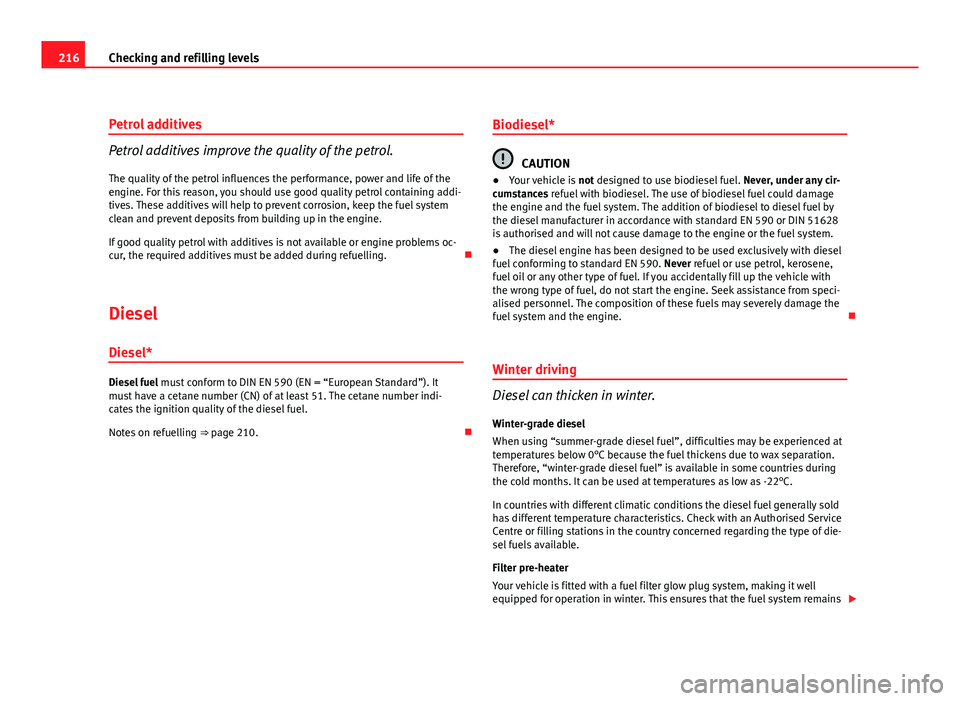
216Checking and refilling levels
Petrol additives
Petrol additives improve the quality of the petrol.
The quality of the petrol influences the performance, power and life of the
engine. For this reason, you should use good quality petrol containing addi-
tives. These additives will help to prevent corrosion, keep the fuel system
clean and prevent deposits from building up in the engine.
If good quality petrol with additives is not available or engine problems oc-
cur, the required additives must be added during refuelling.
Diesel Diesel*
Diesel fuel must conform to DIN EN 590 (EN = “European Standard”). It
must have a cetane number (CN) of at least 51. The cetane number indi-
cates the ignition quality of the diesel fuel.
Notes on refuelling ⇒ page 210. Biodiesel*
CAUTION
● Your vehicle is not designed to use biodiesel fuel. Never, under any cir-
cumstances refuel with biodiesel. The use of biodiesel fuel could damage
the engine and the fuel system. The addition of biodiesel to diesel fuel by
the diesel manufacturer in accordance with standard EN 590 or DIN 51628
is authorised and will not cause damage to the engine or the fuel system.
● The diesel engine has been designed to be used exclusively with diesel
fuel conforming to standard EN 590. Never refuel or use petrol, kerosene,
fuel oil or any other type of fuel. If you accidentally fill up the vehicle with
the wrong type of fuel, do not start the engine. Seek assistance from speci-
alised personnel. The composition of these fuels may severely damage the
fuel system and the engine.
Winter driving
Diesel can thicken in winter.
Winter-grade diesel
When using “summer-grade diesel fuel”, difficulties may be experienced at
temperatures below 0°C because the fuel thickens due to wax separation.
Therefore, “winter-grade diesel fuel” is available in some countries during
the cold months. It can be used at temperatures as low as -22°C.
In countries with different climatic conditions the diesel fuel generally sold
has different temperature characteristics. Check with an Authorised Service
Centre or filling stations in the country concerned regarding the type of die-
sel fuels available.
Filter pre-heater
Your vehicle is fitted with a fuel filter glow plug system, making it well
equipped for operation in winter. This ensures that the fuel system remains
Page 297 of 302
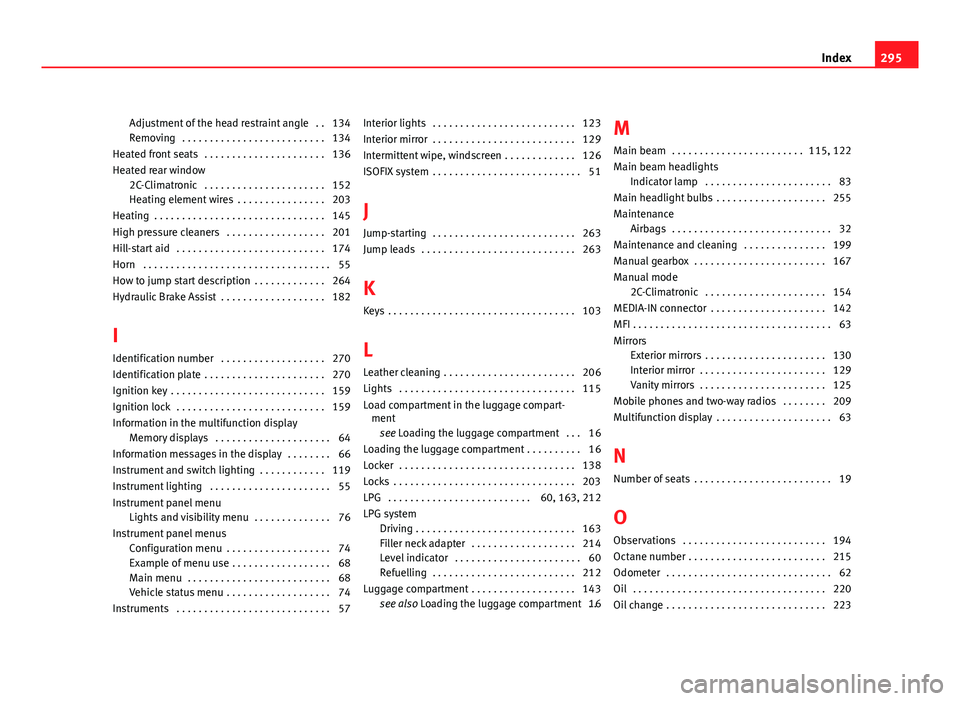
Adjustment of the head restraint angle . . 134
Removing . . . . . . . . . . . . . . . . . . . . . . . . . . 134
Heated front seats . . . . . . . . . . . . . . . . . . . . . . 136
Heated rear window 2C-Climatronic . . . . . . . . . . . . . . . . . . . . . . 152
Heating element wires . . . . . . . . . . . . . . . . 203
Heating . . . . . . . . . . . . . . . . . . . . . . . . . . . . . . . 145
High pressure cleaners . . . . . . . . . . . . . . . . . . 201
Hill-start aid . . . . . . . . . . . . . . . . . . . . . . . . . . . 174
Horn . . . . . . . . . . . . . . . . . . . . . . . . . . . . . . . . . . 55
How to jump start description . . . . . . . . . . . . . 264
Hydraulic Brake Assist . . . . . . . . . . . . . . . . . . . 182
I
Identification number . . . . . . . . . . . . . . . . . . . 270
Identification plate . . . . . . . . . . . . . . . . . . . . . . 270
Ignition key . . . . . . . . . . . . . . . . . . . . . . . . . . . . 159
Ignition lock . . . . . . . . . . . . . . . . . . . . . . . . . . . 159
Information in the multifunction display Memory displays . . . . . . . . . . . . . . . . . . . . . 64
Information messages in the display . . . . . . . . 66
Instrument and switch lighting . . . . . . . . . . . . 119
Instrument lighting . . . . . . . . . . . . . . . . . . . . . . 55
Instrument panel menu Lights and visibility menu . . . . . . . . . . . . . . 76
Instrument panel menus Configuration menu . . . . . . . . . . . . . . . . . . . 74
Example of menu use . . . . . . . . . . . . . . . . . . 68
Main menu . . . . . . . . . . . . . . . . . . . . . . . . . . 68
Vehicle status menu . . . . . . . . . . . . . . . . . . . 74
Instruments . . . . . . . . . . . . . . . . . . . . . . . . . . . . 57 Interior lights . . . . . . . . . . . . . . . . . . . . . . . . . . 123
Interior mirror . . . . . . . . . . . . . . . . . . . . . . . . . . 129
Intermittent wipe, windscreen . . . . . . . . . . . . . 126
ISOFIX system . . . . . . . . . . . . . . . . . . . . . . . . . . . 51
J
Jump-starting . . . . . . . . . . . . . . . . . . . . . . . . . . 263
Jump leads . . . . . . . . . . . . . . . . . . . . . . . . . . . . 263
K
Keys . . . . . . . . . . . . . . . . . . . . . . . . . . . . . . . . . . 103
L
Leather cleaning . . . . . . . . . . . . . . . . . . . . . . . . 206
Lights . . . . . . . . . . . . . . . . . . . . . . . . . . . . . . . . 115
Load compartment in the luggage compart- ment
see Loading the luggage compartment . . . 16
Loading the luggage compartment . . . . . . . . . . 16
Locker . . . . . . . . . . . . . . . . . . . . . . . . . . . . . . . . 138
Locks . . . . . . . . . . . . . . . . . . . . . . . . . . . . . . . . . 203
LPG . . . . . . . . . . . . . . . . . . . . . . . . . . 60, 163, 212
LPG system Driving . . . . . . . . . . . . . . . . . . . . . . . . . . . . . 163
Filler neck adapter . . . . . . . . . . . . . . . . . . . 214
Level indicator . . . . . . . . . . . . . . . . . . . . . . . 60
Refuelling . . . . . . . . . . . . . . . . . . . . . . . . . . 212
Luggage compartment . . . . . . . . . . . . . . . . . . . 143 see also Loading the luggage compartment . .16 M
Main beam . . . . . . . . . . . . . . . . . . . . . . . . 115, 122
Main beam headlights Indicator lamp . . . . . . . . . . . . . . . . . . . . . . . 83
Main headlight bulbs . . . . . . . . . . . . . . . . . . . . 255
Maintenance Airbags . . . . . . . . . . . . . . . . . . . . . . . . . . . . . 32
Maintenance and cleaning . . . . . . . . . . . . . . . 199
Manual gearbox . . . . . . . . . . . . . . . . . . . . . . . . 167
Manual mode 2C-Climatronic . . . . . . . . . . . . . . . . . . . . . . 154
MEDIA-IN connector . . . . . . . . . . . . . . . . . . . . . 142
MFI . . . . . . . . . . . . . . . . . . . . . . . . . . . . . . . . . . . . 63
Mirrors Exterior mirrors . . . . . . . . . . . . . . . . . . . . . . 130
Interior mirror . . . . . . . . . . . . . . . . . . . . . . . 129
Vanity mirrors . . . . . . . . . . . . . . . . . . . . . . . 125
Mobile phones and two-way radios . . . . . . . . 209
Multifunction display . . . . . . . . . . . . . . . . . . . . . 63
N
Number of seats . . . . . . . . . . . . . . . . . . . . . . . . . 19
O
Observations . . . . . . . . . . . . . . . . . . . . . . . . . . 194
Octane number . . . . . . . . . . . . . . . . . . . . . . . . . 215
Odometer . . . . . . . . . . . . . . . . . . . . . . . . . . . . . . 62
Oil . . . . . . . . . . . . . . . . . . . . . . . . . . . . . . . . . . . 220
Oil change . . . . . . . . . . . . . . . . . . . . . . . . . . . . . 223
295
Index